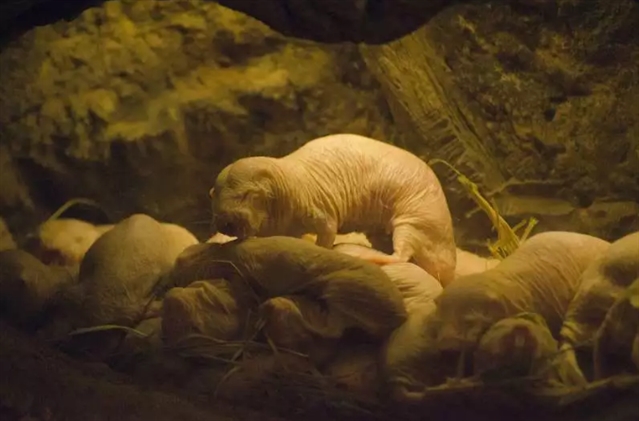论文标题:Naked mole-rat transcriptome signatures of socially suppressed sexual maturation and links of reproduction to aging
期刊:BMC Biology
作者:Martin Bens et al
发表时间: 2018/8/2
数字识别码:10.1186/s12915-018-0546-z
原文链接:https://bmcbiol.biomedcentral.com/articles/10.1186/s12915-018-0546-z?utm_source=Other_website&utm_medium=Website_links&utm_content=DaiDen-BMC-BMC_Biology-Biology-China&utm_campaign=BMCF_USG_BSCN_DD_BMCbBio_Nakedmole-rat
裸鼹鼠群体由2只具有生殖能力的首领和大约300只没有生殖能力的工鼠组成。对于首领而言,繁殖会造成额外的能量消耗,鼠后在生育的基础上还要进行哺乳,本应因此削减寿命,但它们的寿命却比工鼠更长,且终生保有繁殖能力。德国莱布尼茨老年化研究所的研究者们调查了这一悖论背后的遗传学机制,他们的发现近期发表在了开放获取期刊《BMC生物学》(BMC Biology)上。
I
图片来源:Theron Trowbridge on VisualHunt.com / CC BY-NC
研究的通讯作者Martin Bens博士说:“我们的研究结果显示,当裸鼹鼠成熟发育出繁殖能力时,它们的衰老速率也同时被改变了,即首领能够比工鼠活得更久。这很让人吃惊,因为从其他物种身上找到的证据都表明,繁殖虽然对整个物种的生存有益,但却会削减个体的寿命。可是在裸鼹鼠中,生殖似乎可以延长寿命。这与哺乳动物要么将资源用来延长寿命、要么用来繁育后代的普遍认知相悖。”
研究者们从一系列器官(包括心脏、肝和性腺)中提取了组织样本,并对转录组——即所有被转录的基因——进行了分析。他们将有繁殖能力的裸鼹鼠的转录组与工鼠、有繁殖能力的豚鼠、无繁殖能力的豚鼠的转录组分别进行了比较,其中豚鼠是裸鼹鼠的近亲但寿命较短。
作者发现有繁殖能力的裸鼹鼠,其衰老相关的基因的表达与另三者显著不同。比如,一个和肌肉再生相关的基因可能有利于抵抗衰老过程中的肌肉流失,这个基因在有繁殖能力的裸鼹鼠中的表达量更高。类似的基因表达变化可能为裸鼹鼠首领长得异乎寻常的寿命做出了贡献。
Bens博士说:“与不具备生殖能力的豚鼠或其他啮齿类动物不同,不具备生殖能力的裸鼹鼠不会有性别二态性,雌雄鼠之间体型、体重或外生殖器都没有差别,连行为上的差异都很小。我们的研究中最主要也最令人惊讶的发现之一,就是雌雄裸鼹鼠在转录的基因上也没有显著差异。但是我们发现当它们成熟为可繁殖个体后,转录组就会极大地改变。”
当作者把没有生育能力的裸鼹鼠从群体中分离出来,并与异性裸鼹鼠配对后,工鼠便能恢复生育能力。这一转变过程伴随生理和行为上的变化,且雌雄两性的变化不同——也就是说这些动物此时会表现出性别二态性。性成熟的发生,也伴随着长寿和健康相关的基因在表达水平上的变化。
Bens博士说:“对裸鼹鼠转录组数据的深入挖掘,可以帮助我们理解性成熟的调控机制。这可能可以让我们更好地理解人类的性成熟,不同的人青春期起始时间不同,又受很多因素(比如压力和营养)的影响。青春期的起始时间又与很多疾病(如乳腺癌或心血管疾病)的发生相关联。我们的数据可能有助于找到减轻这种差异的靶点。”
在同一天发表在《BMC生物学》上的另一个研究《肝脏蛋白质组的物种间比较揭示其与裸鼹鼠长寿及人类衰老的联系》(Species comparison of liver proteomes reveals links to naked mole-rat longevity and human aging)中,Bens博士与同事比较了裸鼹鼠和豚鼠的肝脏,以进一步研究裸鼹鼠长寿背后的分子机理。
这个研究的通讯作者Alessandro Ori说:“我们发现裸鼹鼠的肝脏在线粒体蛋白的表达上呈现出了一种特别的模式,导致它们的线粒体具备一些与众不同的代谢特征,其中包括较高的脂肪酸利用能力。我们还成功证明,无论是裸鼹鼠还是人类,在衰老过程中受影响的分子网络是类似的,这表明这些网络和这两个物种的长寿之间可能有直接的联系,必经按照体重估算他们的寿命本应短得多。”
摘要:
Background
Naked mole-rats (NMRs) are eusocially organized in colonies. Although breeders carry the additional metabolic load of reproduction, they are extremely long-lived and remain fertile throughout their lifespan. This phenomenon contrasts the disposable soma theory of aging stating that organisms can invest their resources either in somatic maintenance, enabling a longer lifespan, or in reproduction, at the cost of longevity. Here, we present a comparative transcriptome analysis of breeders vs. non-breeders of the eusocial, long-lived NMR vs. the polygynous and shorter-lived guinea pig (GP).
Results
Comparative transcriptome analysis of tissue samples from ten organs showed, in contrast to GPs, low levels of differentiation between sexes in adult NMR non-breeders. After transition into breeders, NMR transcriptomes are markedly sex-specific, show pronounced feedback signaling via gonadal steroids, and have similarities to reproductive phenotypes in African cichlid fish, which also exhibit social status changes between dominant and subordinate phenotypes. Further, NMRs show functional enrichment of status-related expression differences associated with aging. Lipid metabolism and oxidative phosphorylation—molecular networks known to be linked to aging—were identified among most affected gene sets. Remarkably and in contrast to GPs, transcriptome patterns associated with longevity are reinforced in NMR breeders.
Conclusion
Our results provide comprehensive and unbiased molecular insights into interspecies differences between NMRs and GPs, both in sexual maturation and in the impact of reproduction on longevity. We present molecular evidence that sexual maturation in NMRs is socially suppressed. In agreement with evolutionary theories of aging in eusocial organisms, we have identified transcriptome patterns in NMR breeders that—in contrast to the disposable soma theory of aging—may slow down aging rates and potentially contribute to their exceptional long life- and healthspan.
阅读论文原文,请访问
https://bmcbiol.biomedcentral.com/articles/10.1186/s12915-018-0546-z?utm_source=Other_website&utm_medium=Website_links&utm_content=DaiDen-BMC-BMC_Biology-Biology-China&utm_campaign=BMCF_USG_BSCN_DD_BMCbBio_Nakedmole-rat
(来源:科学网)
特别声明:本文转载仅仅是出于传播信息的需要,并不意味着代表本网站观点或证实其内容的真实性;如其他媒体、网站或个人从本网站转载使用,须保留本网站注明的“来源”,并自负版权等法律责任;作者如果不希望被转载或者联系转载稿费等事宜,请与我们接洽。